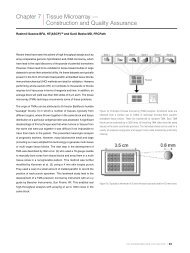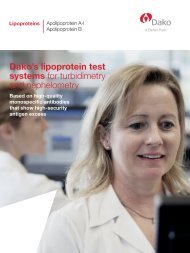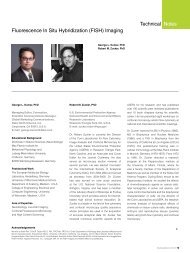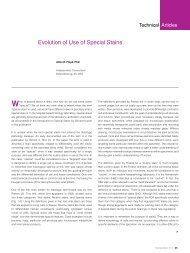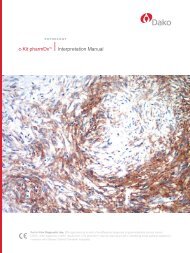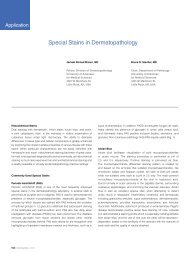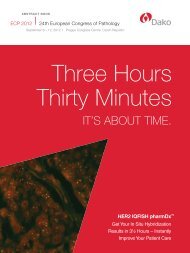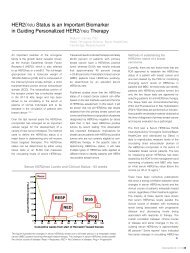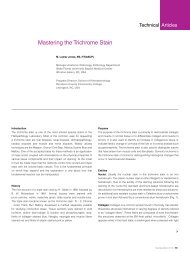Microscopic Quality Control of Haematoxylin and Eosin ... - Dako
Microscopic Quality Control of Haematoxylin and Eosin ... - Dako
Microscopic Quality Control of Haematoxylin and Eosin ... - Dako
You also want an ePaper? Increase the reach of your titles
YUMPU automatically turns print PDFs into web optimized ePapers that Google loves.
H&E<strong>Microscopic</strong> <strong>Quality</strong> <strong>Control</strong> <strong>of</strong> <strong>Haematoxylin</strong><strong>and</strong> <strong>Eosin</strong> – Know your HistologyAnthony Henwood, MSc, CT(ASC)Senior Scientist <strong>and</strong> Laboratory ManagerHistopathology DepartmentThe Children’s Hospital at WestmeadLocked Bag 4001, Westmead, 2145, AustraliaProducing quality microscopic sections goes a long way toachieving a confident, accurate diagnosis. Unfortunately tissuescan be distorted post-operatively, through fixation, during processing,microtomy <strong>and</strong> staining. A competent histological scientist needs to beable to minimise the distortion <strong>and</strong> correct it when the quality processgoes out <strong>of</strong> control. <strong>Quality</strong> staining is highly dependent on fixation<strong>and</strong> processing <strong>and</strong> it is difficult to appreciate histochemical qualitycontrol (QC) in isolation (1). Recognising microscopic quality is directlyconnected with knowledge <strong>of</strong> basic histology <strong>and</strong> recognition <strong>of</strong> thecommon microscopic disease entities. This review analyzes the qualityrequirements for Hematoxylin <strong>and</strong> <strong>Eosin</strong> (H&E) staining.Hematoxylin <strong>and</strong> eosin (H&E) is the “bread <strong>and</strong> butter” stain in mosthistopathology laboratories. It is appreciated that the H&E stain variesfrom laboratory to laboratory <strong>and</strong> that personal preference plays a largepart in the final results. Some general guidelines in assessing a goodH&E are:1. Nuclear detail – how effective is the stain in demonstrating nuclearmembranes, nucleoli, chromatin <strong>and</strong> nuclei <strong>of</strong> both vesicular (open)<strong>and</strong> hyperchromatic (small, dense) nuclei?2. Cytoplasm & background substance – can cell cytoplasm, collagen,muscle, red blood cells <strong>and</strong> mucin be easily discerned?3. In sections <strong>of</strong> appendix, lung or gut is the mucin <strong>of</strong> epithelial cellsblue or clear? The mucin staining is a function <strong>of</strong> the HematoxylinpH. Lowering the pH (usually by adding acetic acid) can significantlyreduce mucin staining.4. Do the haematoxylin-stained elements <strong>of</strong> the section appear brown(indicating an over-oxidised solution)?Luna (1991) (2) believes that an H&E-stained slide should contain thefollowing tinctorial qualities:1. The nuclear chromatin should stain blue to bluish purple <strong>and</strong> bevery distinct.2. Nucleoli should appear reddish purple if the hematoxylin is welldecolourised. If too much hematoxylin remains in the nucleoli, thereis no doubt, that there is excess hematoxylin in the section. Excesseosin will produce a purple monochromatic nuclear chromatin <strong>and</strong>ill-defined nucleoli.3. Collagen <strong>and</strong> muscle should stain well but in a delicate fashion. Oneshould be able to see some form <strong>of</strong> fibrillar pattern by moving themicroscopic focal plain up <strong>and</strong> down. The same pattern is observedby reviewing muscle except that muscle should have a slightlyredder colour than collagen.Connection 2010 | 115
Figure 1. High power H&E showing plasmacells with characteristic cart-wheel nuclei.Figure 2. Colon section stained with H&Eshowing blue mucin staining. Decreasing thehematoxylin pH should remove this staining.116 | Connection 2010
4. <strong>Eosin</strong>ophilic granules should be well-defined <strong>and</strong> appear orangered.Lack <strong>of</strong> well-defined eosinophilic granules suggests overstainingby either hematoxylin or eosin, or both.These are general guidelines but are there guidelines for individualtissues?When assessing H&E-stained sections from differing organs, featuresthat are usually present are arteries. One should be able todifferentiate muscle <strong>and</strong> collagen with muscle appearing as darkred. Red blood cells should be bright red. Assessment <strong>of</strong> nuclearstaining will depend on the cell-types in the tissue being stained <strong>and</strong>the following is an attempt to set some st<strong>and</strong>ards according to thetissue being assessed.Nervous TissueThe Nissl substance <strong>of</strong> neurones <strong>and</strong> Purkinje cells should be welldemarcated <strong>and</strong> stain dark blue. The large nuclei should be open with avisible nucleolus. The fibres should be delicately eosinophilic which willallow easier demonstration <strong>of</strong> senile plaques if present. The pale pinkstaining <strong>of</strong> neurones will also allow easier detection <strong>of</strong> “red” neurones,an important indicator <strong>of</strong> antemortem injury (3).PituitaryThe pituitary contains three principle cell types that should be apparentwith a good H&E: acidophils (40%) with pink cytoplasm, basophils(10%) with a pale blue cytoplasm <strong>and</strong> chromophobes (50%) with clearcytoplasm. The nuclei <strong>of</strong> acidophils should have relatively prominentnucleoli (3).Figure 3. Skin section stained H&E. A (Left) pH <strong>of</strong> eosin too high, B (Right) acidic eosin showing differentiation <strong>of</strong> collagen <strong>and</strong> neural tissue.Connection 2010 | 117
ThyroidColloid should be pale pink. The cytoplasm <strong>of</strong> follicular cells shouldbe a slightly darker pink. The nuclei should be delicately stained withdiscernible small darker chromatin. The basement membrane bindingthe follicular cells should be visible <strong>and</strong> appear as deep red. In wellfixed <strong>and</strong> processed tissue, Clear cells may be seen admixed with thefollicular cells (4).“H&E stain varies from laboratory to laboratory<strong>and</strong> that personal preference plays a large partin the final results. ”ParathyroidThe two cell types should be recognisable. Chief cells should have clearto faint pink cytoplasm with even blue chromatin, <strong>and</strong> rare small nucleoli.The cell membrane should be poorly defined. Oxyphil cells should showan eosinophilic granular cytoplasm, pyknotic nuclei <strong>and</strong> should have aprominent cell membrane (3).RespiratoryThe bronchioles contain smooth muscle <strong>and</strong> collagen in their walls. Thelung parenchyma is rich in small blood vessels <strong>and</strong> thus eosin balancebetween muscle <strong>and</strong> collagen can be assessed. In the alveoli, typeII pneumocytes should have pale nuclei with prominent nucleoli. Thenuclei <strong>of</strong> type I pneumocytes are small <strong>and</strong> dense (4).Gastrointestinal TractThe gastrointestinal (GI) tract contains epithelial, connective, neural <strong>and</strong>lymphoid tissues that need to be easily recognisable using a routineH&E. Lymphoid nuclei, especially those <strong>of</strong> plasma cells, should beassessed. The usual colour differentiation should exist between muscle<strong>and</strong> collagen. Ganglion cells should be apparent in between the musclelayers. The nuclei should contain a single, prominent, eosinophilicnucleolus <strong>and</strong> the cytoplasm should be pink (a lighter hue than that <strong>of</strong>the surrounding muscle). It is expected that the epithelial mucin shouldbe clear. Blue staining <strong>of</strong> the mucin usually indicates that the pH <strong>of</strong> theHematoxylin is too high (Fig. 2). It has <strong>of</strong>ten been found that in thesecases, the hematoxylin <strong>of</strong>ten appears over-stained resulting in difficultyin assessing the nuclear component. Throughout the GI tract there areunique cells that exist <strong>and</strong> it important that they be recognised in agood H&E:HeartThe heart is rich in blood vessels as well as cardiac muscle <strong>and</strong> collagenenabling good eosin differentiation. Purkinje fibres, if present, shouldhave pale cytoplasm with open vesicular nuclei. Cardiac nuclei shouldhave evenly distributed dust-like chromatin with a clear (non-staining)perinuclear sarcoplasm. The eosin should demonstrate the crossstriationsadequately (5).Lymph NodeIn the germinal centres, centroblasts have large, round, vesicularnuclei with 1-3 small but conspicuous nucleoli. Small lymphocytes havedark staining, irregular nuclei. Plasma cells with their “spoke-wheel”chromatin pattern caused by small clumps <strong>of</strong> chromatin on the nuclearmembrane in a clear nucleus may be present (Fig 1). A clear “h<strong>of</strong>”should be seen (3).In the stomach, the parietal cell cytoplasm should be light pink, whereas that <strong>of</strong> the chief cells should appear purplish. Small nucleoli shouldalso be apparent in the chief cells (3).Paneth cells, showing intensely eosinophilic cytoplasmic granules,should be present in the small intestine.In the large bowel, the nuclei <strong>of</strong> the goblet cells should appear darkerthan those <strong>of</strong> the absorptive cells. Endocrine <strong>and</strong> Paneth cells shouldbe discernible by the eosinophilic granules present in the cytoplasm.LiverThe predominant cell is the hepatocyte. The nuclei should have smallnucleoli visible. The pale red-pink cytoplasm <strong>of</strong> the hepatocytes shouldcontrast well with the pink <strong>of</strong> collagen around blood vessels. Thereshould also be small blue granules (RER) in the cytoplasm. Cuboidal bileduct cells have open nuclei <strong>and</strong> dark pink cytoplasm (3).118 | Connection 2010
SpleenThe cell population in the spleen is similar to the lymph node so you canrecognise similar microscopic quality control features. Both mediumsized <strong>and</strong> small lymphocytes are present. Plasma cells are <strong>of</strong>ten foundnear the arteries. The endothelial cells lining the sinus should have beanshapednuclei containing a longitudinal cleft (3).PancreasThe pancreas has a wide variety <strong>of</strong> cells to meet the exocrine <strong>and</strong>endocrine functions <strong>of</strong> the organ:Acinar cells have dark nuclei with a few tiny clumps <strong>and</strong> str<strong>and</strong>s <strong>of</strong>chromatin. Nucleoli should be evident. The cytoplasm should haveintense eosinophilia at the apical with strong hematoxylinophilicstaining at the basal end.Duct cells have clear to pale eosinophilic cytoplasm <strong>and</strong> lightlystained nuclei (less dense than those <strong>of</strong> acinar cells).Islet cell nuclei should have evenly stained nuclei <strong>and</strong> cytoplasma paler pink than acinar cells. Within the islet, differing cells shouldbe discerned with darker cytoplasm cells probably being glucagoncontaining cells (3).KidneyThe kidney contains a diverse population <strong>of</strong> cells from those exhibitingdense chromatin (in the glomerular tufts) to those exhibiting a dusting<strong>of</strong> chromatin material (cuboidal cells <strong>of</strong> the collecting tubules) (2).The cytoplasm <strong>of</strong> the cells <strong>of</strong> the Proximal Convoluted Tubules haveeosinophilic cytoplasm where as those <strong>of</strong> the Distal Convoluted Tubuleshave paler cytoplasm (fewer granules). The cells <strong>of</strong> the ProximalConvoluted Tubules should have a discernible brush border. Thebasement membranes <strong>of</strong> both proximal <strong>and</strong> efferent tubules shouldbe visible (5).In the medulla, the chromaffin cells should have an overall bluecytoplasm. The nuclei should have coarsely clumped chromatin withvisible clear areas. The nuclear material <strong>of</strong> the ganglion cells should bespeckled <strong>and</strong> have prominent nucleoli.Three zones should be visible in the cortex. The zona glomerulosa(closest to the capsule), the cells should have clear cytoplasmcontaining a scattering <strong>of</strong> pink granules. The nuclei should have alongitudinal groove present in many <strong>of</strong> the cells. In the middle zone(zona fasciculata) the nuclei should be more vesicular <strong>and</strong> lesschromatic than in the previous zone. A single small nucleolus should beapparent <strong>and</strong> the cytoplasm should be clear. In the zona reticularis, thecells have cytoplasm that is solid, granular <strong>and</strong> eosinophilic. Lip<strong>of</strong>uscinshould be discernible especially in cells adjacent to the medulla (3).ProstateThe stroma <strong>of</strong> the prostate contains both collagen <strong>and</strong> smooth muscle<strong>and</strong> these should be easily differentiated on an H&E. The secretaryepithelial cells <strong>of</strong> the central zone <strong>of</strong> the prostate should havedarker cytoplasm <strong>and</strong> slightly darker nuclei compared to those in theperipheral zone (3).TestisThe main features <strong>of</strong> the testis that need to be recognised include (3):Sertoli cells – nuclei should have a slightly wrinkled nuclearmembrane <strong>and</strong> have prominent nucleoli.Germ cells – You should be able to easily distinguish each <strong>of</strong> thedifferentiating elements based on the presence or absence <strong>of</strong>nucleoli <strong>and</strong> chromatin pattern. A good H&E is imperative.Leydig cells – have prominent nucleoli, the cytoplasm is intenselyeosinophilic <strong>and</strong> the eosinophilic crystalloid <strong>of</strong> Renke shouldbe visible.Adrenal Gl<strong>and</strong>Under low magnification, the cortex <strong>and</strong> medulla <strong>of</strong> the adrenal gl<strong>and</strong>should be apparent with acidophilic (pink) cortex <strong>and</strong> basophilic(blue) medulla.EndometriumThe endometrium contains epithelial <strong>and</strong> mesenchymal elements<strong>and</strong> these need to be differentiated with a good H&E. Prominentnucleoli should be apparent in the proliferating gl<strong>and</strong>ular epithelium.The smooth muscle <strong>of</strong> the myometrium should contrast well with thesupporting collagen (4).Connection 2010 | 119



